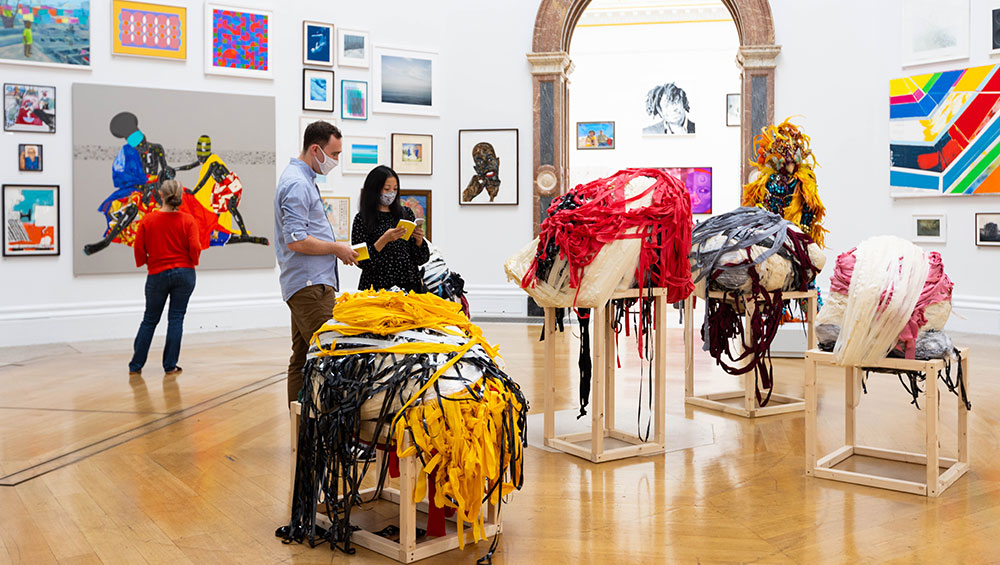
Summer Exhibition 2021, installation view, Royal Academy of Arts, London. Photo: © Royal Academy of Arts, London / David Parry.
Royal Academy of Arts, London
22 September 2021 – 2 January 2022
by BETH WILLIAMSON
The 1951 Festival of Britain was famously billed as “a tonic to the nation”. Seventy years on and in the wake of a pandemic, this year the 253rd Summer Exhibition is something of a tonic too. As the exhibition’s coordinator, Yinka Shonibare, has said: “This exhibition seeks a return to the visceral aspects and the sheer joy of art-making. It will celebrate the transformative powers of the magical in art and transcend the western canon which formed the foundations of the Royal Academy, seeking to restore value to marginalised practices as equally valid forms of enlightenment.”
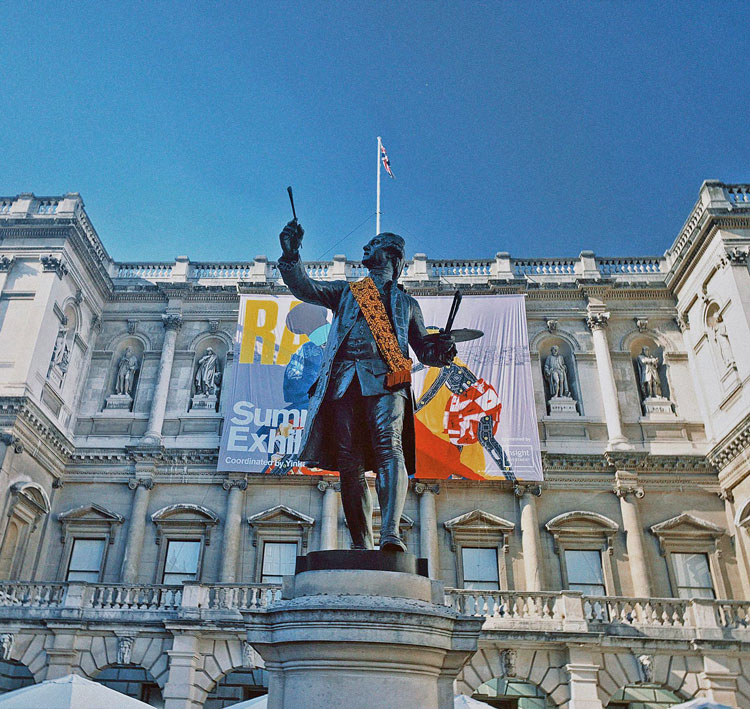
Alfred Drury’s statue of Sir Joshua Reynolds PRA in the courtyard of the Royal Academy of Arts wears a sash of Dutch wax print. Photo: William Kennedy.
A joyful exhibition, however, does not mean it is lacking in serious themes. The works selected may, at time, test the conventions of the Summer Exhibition, and the Royal Academy itself, but they do so with a lightness of touch that makes their challenges all the more effective. The challenges begin even before you enter the building. Alfred Drury’s statue of Sir Joshua Reynolds PRA, installed in the courtyard on 12 December 1931, wears a sash of Dutch wax print fabric, the trademark of Shonibare’s work and shot through with difficult colonial histories. This simple act of adornment says so much and marks the tone for what is displayed inside the galleries.
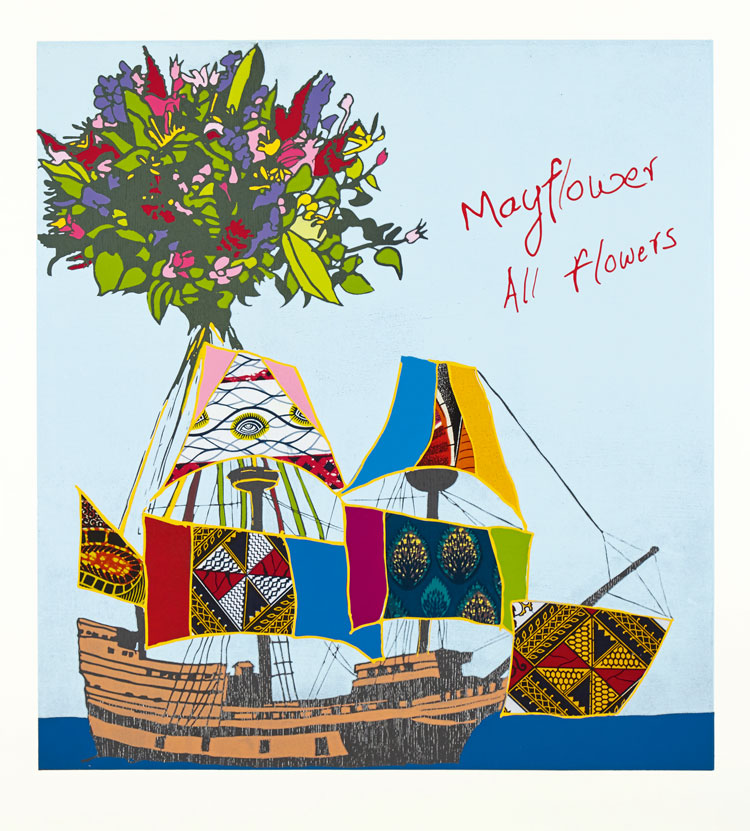
Yinka Shonibare. Mayflower, All Flowers. Relief print with woodblock and fabric collage on somerset tub sized satin 410gsm paper, 111.5 x 103 cm. Courtesy the artist and Cristea Roberts Gallery, London © Yinka Shonibare.
Among the display of prints, paintings, photographs, film, sculpture and architectural works, you will find a more diverse array of artists this year. Njideka Akunyili Crosby, Jade Montserrat, Hew Locke and Rita Keegan all have work included. Self-taught artists such as Frantz Lamothe, Bärbel Lange and Marie-Rose Lortet are represented too.
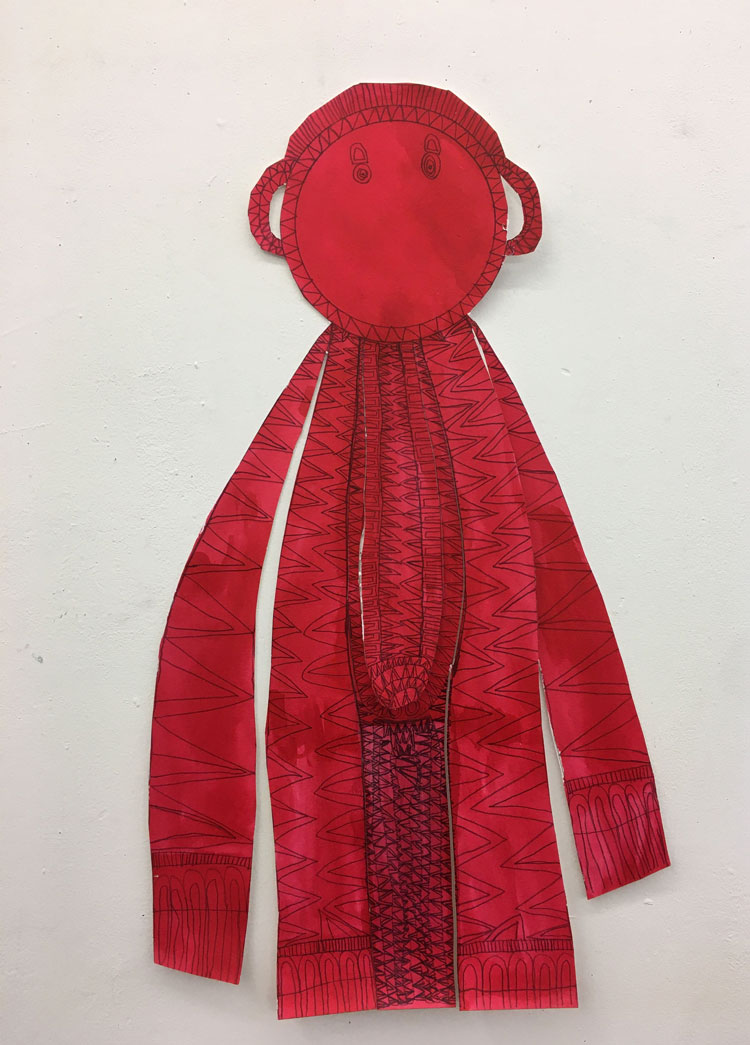
Bärbel Lange. Bear. Mixed media, cutout (paper, pencil, China ink), 105 x 75 x 5 cm. Copyright Kunsthaus KAT18.
As Shonibare puts it: “Previously invisible voices have been championed and many artists are showing here for the first time.” His starting point was the work of Bill Traylor (1853-1949). Traylor was born into slavery, a self-taught artist who did not begin making art until he was 85 years old. He inspired Shonibare to look beyond the boundaries of western art history.
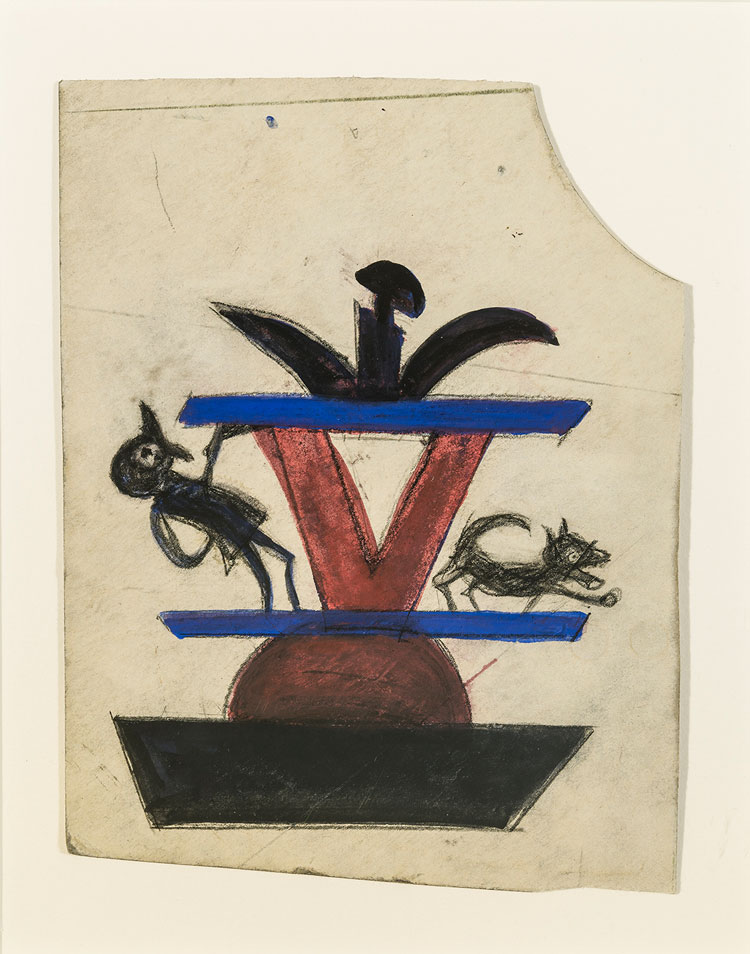
Bill Traylor. Man with Barking Dog (Blue and Red Construction). Poster paint and pencil on cardboard, 15.24 x 12.07 cm. Photo © Eric W. Baumgartner. Courtesy of Hirschl & Adler Modern.
Arthouse Unlimited, a charity that presents the artistic talents of adults living with complex neurodiverse and physical support needs, has three of its artists included – Simon Hammond, Laura Tregellas and Stephen Thomson all have work exhibited. Outside In, another charity that provides a platform for artists who face barriers due to health, disability or social circumstances, also has artists included in the exhibition, which is great to see. Colin Cameron’s Family, Picking Noses and Mourner’s Picking Noses are simply witty. Patrick Moses’s Pop Tarts shows an astonishing use of colour, while Jan Arden’s work demonstrates its indebtedness to folk art. Nnena Kalu’s sculptures are made from cling film, fabric, masking tape, coloured tape, drainage tubes, paper and VHS tape, and they are curiously captivating.
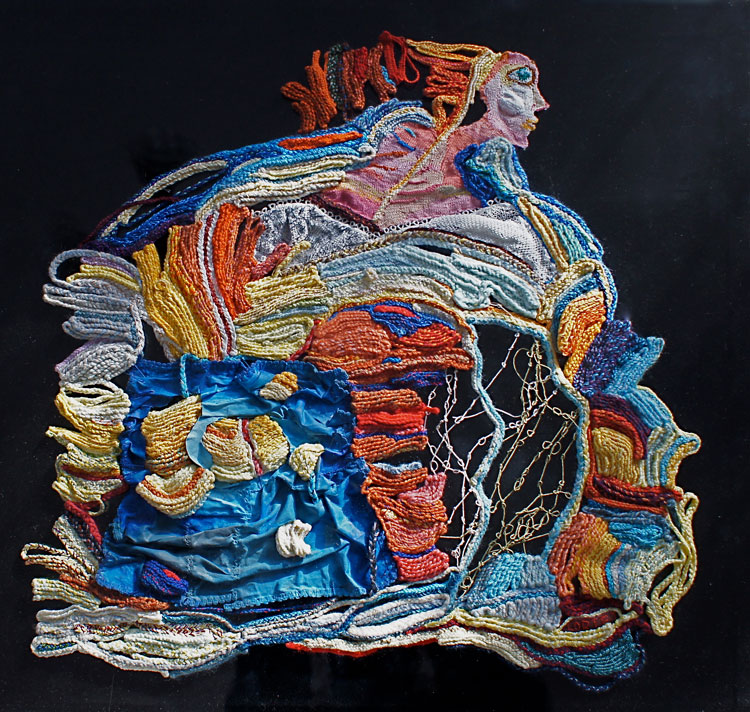
Marie-Rose Lortet. En tournant la tête. Silk and cotton threads, textile, 56 x 60 x 8 cm. Photo © Clovis Prévost. Courtesy Marie Finaz Gallery.
I think what Shonibare has done is to show how including those invisible and marginalised artists enriches the exhibition. The usual run of amateur artists and academicians is not halted but interrupted so that works are seen afresh. There are too many RAs to mention here, but work by some of them seems to me to especially strike the right tone for this year’s show. David Nash’s quartet Ash Dome – Four Seasons is full of green and growing hope. It is hung next to two prints by Barbara Rae, colourful, exuberant and life-affirming. Ann Christopher’s hanging sculpture Holding Shadows proves its innate elegance and stillness, despite being jostled on all sides by other works. It really deserves more space but is quietly compelling enough not to demand it. In another room, three of Christopher’s Broken Time drawings hold their own space amongst the fray.
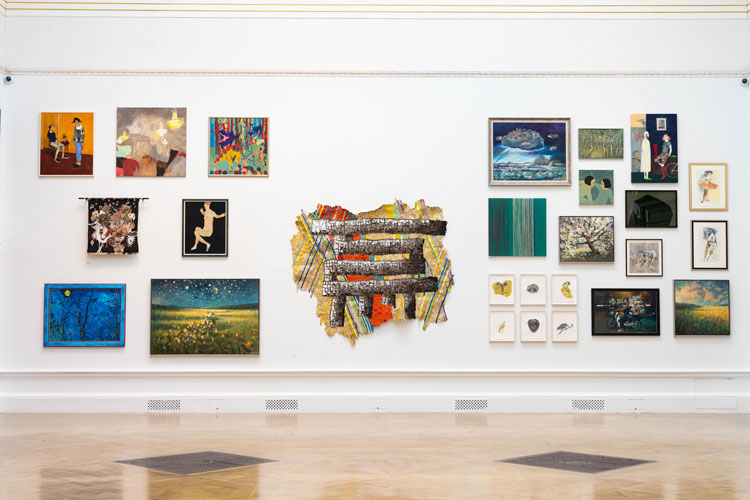
Summer Exhibition 2021, installation view, Royal Academy of Arts, London, 22 September 2021 – 2 January 2022 showing El Anatsui Hon RA, Dexterity. Photo: © Royal Academy of Arts, London / David Parry.
Elsewhere, Anne Desmet’s historically situated wood engravings comment on contemporary times, as in Triptych for our Times, in which the central image of a stone carved angel is wearing the now-ubiquitous disposable blue face mask. Italian Light is less direct in its contemporary relevance. This complex combination of lithograph, wood engraving and monotype print on paper collaged under glass shows Roman and Venetian buildings. As Desmet explains, the monotype included in the work “is from lino salvaged from a London primary school and bearing the indentations of teachers’ stiletto heels and table and chair legs”. It is a novel approach to bringing distant and recent past together in the present.
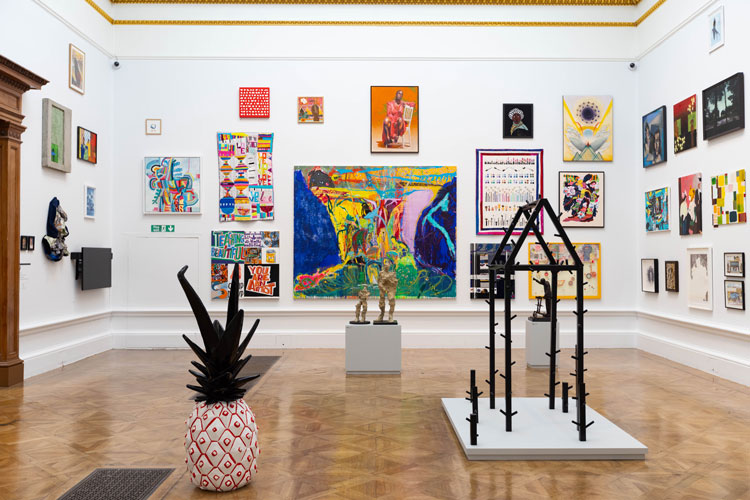
Summer Exhibition 2021, installation view, Royal Academy of Arts, London, 22 September 2021 – 2 January 2022. Photo: © Royal Academy of Arts, London / David Parry.
The RA is still the world’s largest open submission contemporary art show, but even the range of media shifts a little this year with a commissioned sound programme including work from artists such as Linton Kwesi Johnson, Peter Adjaye, Nyege Nyege, Ceyda Oskay, Larry Achiampong, Pelin Pelin and the Black Obsidian Sound System collective. These sound works span spoken word, poetry, abstract soundscapes and musical arrangements, all of which explore the exhibition’s themes. These are available to listen to on the Royal Academy’s website: smartify.org/tours/summer-exhibition-2021.
A small, dedicated gallery space shows Peripeteia (2012), an utterly enthralling video work by John Akomfrah RA. The film takes as its starting point two drawings by Albrecht Dürer – Head of Negro (1508) and Portrait of the Moorish Woman Katharina (1520). These are among the earliest western representations of black people. Akomfrah develops these two characters into the film’s protagonists. They wander a moorland landscape while the past is implied in the present. It is disturbing, beautiful and compelling viewing. That difficult combination of thoughts, feelings and experiences is what comes through this entire exhibition. Three works from Peter Randall-Page’s A Little Bit of Infinity Stone series, for me, gesture to the infinite possibilities for the Summer Exhibition of the future. Shonibare has done a tremendous job this year and it is proof that even an exhibition in its 253rd year can change. It is at once joyous and serious, and I hope it is a new beginning.